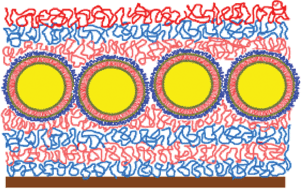Composite multilayered biocompatible polyelectrolyte films with intact liposomes: stability and temperature triggered dye release†
Abstract
The design of new quasi-2D biocompatible films able to release a

* Corresponding authors
a
Institut National de la Santé et de la Recherche Médicale (INSERM), Unité 595, 11 rue Humann, 67085 Strasbourg Cedex, France
E-mail:
Dmitry.Volodkin@medecine.u-strasbg.fr
b Université Louis Pasteur (ULP), Faculté de Chirurgie Dentaire, 1 place de l'Hôpital, 67000 Strasbourg Cedex, France
c Institut Charles Sadron (ICS), Centre National de la Recherche Scientifique, Unité Propre 22, 6 rue Boussingault, 67083 Strasbourg Cedex, France
d Max-Planck Institute for Colloids and Interfaces (MPI), D-14424 Potsdam, Germany
The design of new quasi-2D biocompatible films able to release a

 Please wait while we load your content...
Something went wrong. Try again?
Please wait while we load your content...
Something went wrong. Try again?
D. Volodkin, Y. Arntz, P. Schaaf, H. Moehwald, J. Voegel and V. Ball, Soft Matter, 2008, 4, 122 DOI: 10.1039/B713563G
To request permission to reproduce material from this article, please go to the Copyright Clearance Center request page.
If you are an author contributing to an RSC publication, you do not need to request permission provided correct acknowledgement is given.
If you are the author of this article, you do not need to request permission to reproduce figures and diagrams provided correct acknowledgement is given. If you want to reproduce the whole article in a third-party publication (excluding your thesis/dissertation for which permission is not required) please go to the Copyright Clearance Center request page.
Read more about how to correctly acknowledge RSC content.
 Fetching data from CrossRef.
Fetching data from CrossRef.
This may take some time to load.
Loading related content
